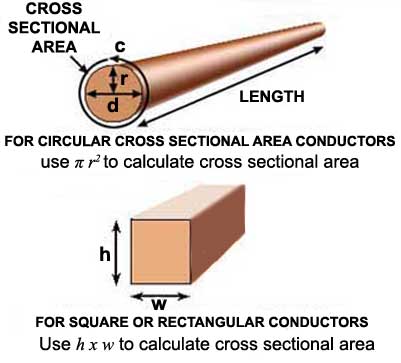Google Ads
Module 1.3
Resistance in Conductors
- After studying this section, you should be able to:
- • Calculate the dimensions of a conductor.
- • Describe the effect of length and cross sectional area on the resistance of a conductor.
How the Dimensions of a Conductor Affect its Resistance
A conductor is any material that will allow an electrical current to flow through it. The ability of any conductor in an electrical circuit to pass current is judged by its electrical RESISTANCE. Resistance is the ability to OPPOSE the flow of electric current. Voltage is the electrical force that causes current to flow through a conductor, but the greater the value of resistance of any conductor, the less current will flow for any particular value of voltage applied. The resistance of a conductor depends mainly on three things:

Fig. 1.3.1Calculating the Dimensions of a Conductor
1. The LENGTH of the conductor.
2. The CROSS SECTIONAL AREA of the conductor.
3. The MATERIAL of which the conductor is made.
Because the resistance is greater in longer conductors than in shorter ones, then:
RESISTANCE (R) IS PROPORTIONAL TO LENGTH (L)
and is written as R ∝ L (∝ means proportional to...)
Therefore the longer the conductor, the more resistance is present and so less current flows.
Also, because resistance is less in conductors with a large cross sectional area:
RESISTANCE (R) IS INVERSELY PROPORTIONAL TO CROSS SECTIONAL AREA (A)
Which is written as R ∝ 1/A (or R ∝ A-1).
The greater the cross sectional area, the more current can flow along the conductor, so the lower the value of the conductor´s resistance.
Circular Conductors
When the conductor has a circular cross section, the area of a circle can be found by using the formula:
π r2 Where π = 3.142 and r is the radius of the circle.
If the cross section of the conductor is square or rectangular, the cross sectional area of the conductor can still be found by simply multiplying the width by the height. Most conductors, found in cables etc. are of course circular in cross section.
The Material from which the conductor is made also affects its resistance, by an amount depending on the RESISTIVITY of the material, described in Resistors & Circuits Module 1.4.
Google Ads


